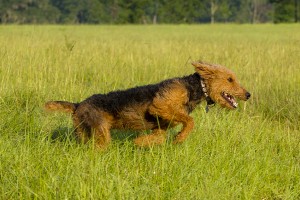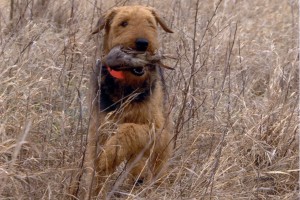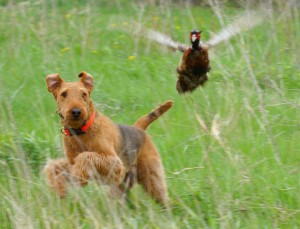 In the beginning, Airedales were hunting dogs. The working class people in the West Riding of Yorkshire, who developed the breed, needed a dog that could scent game, had the size to be able to tackle larger animals and could be taught to retrieve. The answer to this need turned out to be the Airedale.
In the beginning, Airedales were hunting dogs. The working class people in the West Riding of Yorkshire, who developed the breed, needed a dog that could scent game, had the size to be able to tackle larger animals and could be taught to retrieve. The answer to this need turned out to be the Airedale.
Airedales imported to the U.S. in the early 1900s were popular all-purpose hunting dogs. But in the ensuing decades, as more hunters became "specialists," who only hunted upland birds or waterfowl or small game, they wanted their dogs to also be specialists. There was little room left in the hunting fraternity for an all-around hunting dog like the Airedale.
So for generations the breed floated on the fringes of hunting society, thought of as pets, show dogs, obedience dogs and sometimes as guard dogs, but rarely as hunting companions. Oh, a few diehards bred, raised and used their Airedales as hunters, but they were few and far between, even in the Airedale community.
In the mid-1980s, however, as hunt tests came into existence and many breed parent clubs (besides sporting dogs) sought to find a way to provide a meaningful testing program for their particular breed's historical work, the Airedale folks began a hunting/working program for their breed that tested the dogs as upland hunters, retrievers and small fur hunters.
This eventually led, in 2009 after a long and sometimes seemingly futile struggle with the American Kennel Club, to Airedales being approved for eligibility in the AKC's spaniel hunt test program. This has resulted in an increasing number of Airedalers using their dogs for the purpose they were intended.
So the first questions, for those unfamiliar with the breed as a hunter, are probably "How does an Airedale hunt? And what other sporting breed(s) do they resemble in the field?"
"They seem to have different hunting styles," said Tom McPeek, whose dog Sadie (Seneca Sadie's Lucky Day SH MHFur SHF JHR JHV) has a senior hunter title from the AKC as well as working titles from the Airedale Terrier Club of America. "My dog will rip a field apart, leaving no blade of grass unturned, vacuuming in the scent of the entire field like a maniac.
"She is excellent at spotting cover and has no fear of a thick briar patch, windbreak or other thorny areas where birds may be hiding," McPeek noted. "My wife's Airedale, on the other hand, hunts in a much more methodical manner, which may be more typical of the breed as a whole. She air scents and hunts at about the same speed as a Clumber spaniel."
Scott Lichty, whose dog Bob (Regent Wasabi UD JH GN RA) was one of the first Airedales to earn a hunt test title, added, "Generally, the Airedale is a methodical hunter. Most are not very fast as they run through a field, but they are thorough. They have great noses and can pick up scent from a long distance.
"They also have great stamina and can work long periods of time. While they are not as fast as springers or cockers, they are far faster than Clumbers. They are also much more controlled than Labradors, as they seem to pace themselves much better."
Sandi Cooley, whose dog Winston was an accomplished field dog, show champion and outstanding sire of field dogs, currently owns Winston's granddaughter, Tulla (Ch. Strongbow Tullamore Dew JH CGC). "They have a methodical, deliberate style, using their intelligence and outstanding noses to get the job done," Cooley said. "They rarely waste any energy in the field. I'd say their style most closely resembles a Chesapeake in upland bird work.
"Of course, that may just be because both breeds seem to have a pretty wide streak of independence. They aren't comparable to the Chessies in the water, but then there isn't much in the world of sporting dogs that is comparable to the Chesapeake on waterfowl!"
 Like all sporting breeds, Airedales have certain strengths as a hunting dog as well as some weak areas. "Their greatest strength is their unrelenting desire to hunt," said Mark Werner, whose Airedale Hannah has three qualifying scores toward her senior hunter title. "Their greatest weakness is listening and obeying.
Like all sporting breeds, Airedales have certain strengths as a hunting dog as well as some weak areas. "Their greatest strength is their unrelenting desire to hunt," said Mark Werner, whose Airedale Hannah has three qualifying scores toward her senior hunter title. "Their greatest weakness is listening and obeying.
"There are also some that don't like to swim. We have one that doesn't like to get her feet wet but the other is like a muskrat in the water and swims like a torpedo. As a whole, though, they are more confident on land than in the water."
Deeann Corby-Lulik owns Ch. MACH7 Connemara's Tuff Act To Follow MH CDX TQX2 JHV SHFur SHF RE MXF TDI CGC ("Kaleigh"), the first Airedale to achieve master hunter status. "Their greatest strength is their tenacity and determination to get in the game. They don't get discouraged easily and they are great problem-solvers," Corby-Lulik said. "But they have problems with steadiness and 'impulse control.'
"Doing retriever work, it isn't so bad, but on upland game, oh boy! There's a certain deafness to the whistle that can occur. Sometimes, when they have trapped a few birds or snagged them out of mid-air, they aren't happy about sitting or even stopping on the flush."
Joyce Contofalsky, whose dog Ella has her junior hunter title, shared similar thoughts. "Good determination. They don't quit," she said. "They always want to keep going, which can also be a weakness. You really have to make sure you include some 'no bird' training with an Airedale.
"The other weakness the breed generally has is water work. When they are asked to make a retrieve in a strange pond, one where they've never worked previously, they may be reluctant to go in without a lot of encouragement. Once they know a pond, it's no problem. Airedales are a cautious breed. They look before they leap."
"Airedales are stubborn, independent and at any given time can show you that they have a mind of their own," Cooley added. "They are easily distracted and they need to be trained with short sessions or they get bored. They do best with positive reinforcement as they tend to shut down if there is too much that's negative in training and too much is 'forced' on them.
"It is a real challenge to find a way to move forward in the field with an Airedale without breaking the dog's spirit. But they love to work, although they are better as upland hunters than waterfowl dogs simply because upland work has more of an independent nature to it. You do, however, have to keep training fun and exciting for them. They're willing to do almost anything as long as there is some reward for doing it."
With an unusual hunting breed like an Airedale, it can be a problem to find professional help when you need it, but most of these Airedalers have been successful. "Bob's training really began with my wife, who does competitive obedience, so he had some good basic training before we started training him to hunt," Lichty said.
"Initially I joined retriever classes that were being taught by a retriever hunt test judge, who was very encouraging. She told me that my Airedale was not a Lab and I shouldn't expect him to be like one. She said Bob would be fine in the field and all I needed was patience. She turned out to be right.
"More recently, I have developed better connections to the spaniel community and found a good spaniel trainer. The motivational, but firm philosophies of spaniel trainers, seem to be well-suited for Airedales. Any trainers who use excessive pressure to achieve results should quickly be avoided. Spaniel club membership is now open to Airedale folks as well as spaniel training workshops.
"As more people have seen the dogs work at the tests and see their capabilities, more are willing to give them a chance. As a result, more spaniel trainers and even a few retriever trainers are now willing to try training an Airedale," Lichty concluded.
Admittedly, this is a breed where hunting ability has not been a primary consideration in most breeders' decisions for several decades. So how does someone find an Airedale puppy that wants to hunt?
"If you are looking for a hunting puppy, you have to be a hunter at heart. Puppies from hunting dogs aren't going to necessarily be great hunting dogs on their own," Werner said. "What really matters is the amount of heart and soul you are willing to put into training your dog to hunt.
"If you are not willing to put in a lot of effort, an Airedale will likely just be a mediocre hunting companion. However, you should also attend hunt tests to talk with the owners and handlers to get an idea of how the breed works in the field.
"Remember also, that good breeders will screen prospective buyers first on their understanding of the breed and then on whether your lifestyle is suitable to the demands of the breed and why you are interested in a puppy. Reputable breeders will point you in the direction of successful hunting bloodlines versus those that are strictly conformation dogs or family pets," Werner stated.
"Good working Airedales are out there, but it does take some research to find them," Corby-Lulik said. "People can boast that their dog is the best this or that, but having titles is at least proof that the dog's abilities met a certain standard.
"You also can look for a lot of working history in the dog's background. Even though most of the work may not be in the field, their accomplishments do involve having a good working attitude and drive. For example, one of my MH dog's grandfathers was a drug detection dog.
"In addition you may find obedience, flyball racing titles and agility titles. While these aren't the same as hunting titles, they do require some of the same traits that a good gun dog should have — drive, a good nose, trainability, a solid temperament, athleticism, problem-solving skills and a physical structure that lends itself to working longevity."
 "Look for Airedales with advanced hunting titles — in other words, titles at the senior or master level," McPeek advised. "Go to hunt tests and training opportunities, and watch the dogs at work. If you see a dog that impresses you, ask about that dog and its pedigree. Contact the breeders of these dogs and see if they are making breeding decisions based on the characteristics of good hunting dogs.
"Look for Airedales with advanced hunting titles — in other words, titles at the senior or master level," McPeek advised. "Go to hunt tests and training opportunities, and watch the dogs at work. If you see a dog that impresses you, ask about that dog and its pedigree. Contact the breeders of these dogs and see if they are making breeding decisions based on the characteristics of good hunting dogs.
"There are breeding lines in Airedales that have strong hunting and working traits. I was very lucky when we bought Sadie because I had no idea they were hunting dogs and we simply purchased a pet. If someone had told me I would be hunting wild pheasants in South Dakota over an Airedale, or achieving a senior hunter title on an Airedale, I would have questioned their sanity."
"If you want to hunt, make sure birds are a part of your puppy test," Contofalsky said. "Ella's sire, Winston, was a great hunter. But my second hunting dog, Pistol Pete, came strictly from show lines. However, he had a lot of bird instinct even as a puppy.
"One good way to find a breeder is to contact the Airedale Terrier Club of America. They can direct you to members and breeders that are interested in hunting. The club also sponsors hunt tests, which can be very useful when you are looking for a pup from working lines."
"With a breed like this, I would look for breeders that are willing to evaluate a litter for natural instinct, ability and enthusiasm," said Cooley who, like Corby-Liluk, is a breeder. "Over the years, I have seen many 6- and 7-week-old pups show extreme birdiness. This is something a buyer should look for, not just whether the parents were field dogs.
"From my experience it doesn't appear that the field ability has been bred out of the modern Airedale. They have been, and always will be, a 'three-for-one' versatile hunting dog with strong natural instincts for upland, waterfowl and fur hunting. They are willing to hunt and bring back anything you can shoot."






